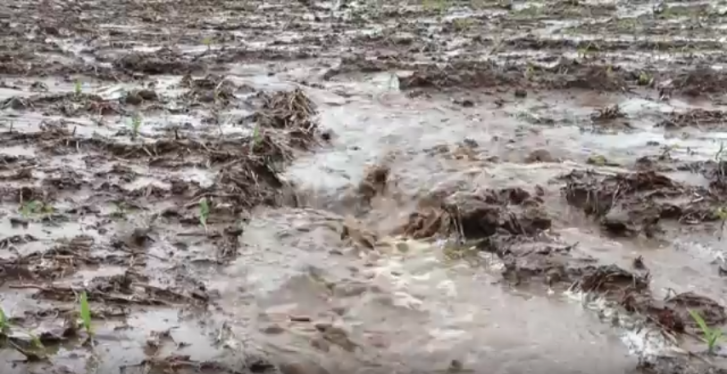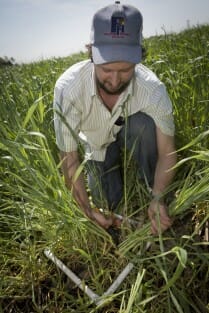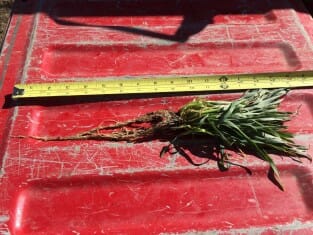ASA Scouting Plan for Cover Crop Success
“We have an infiltration problem, not a runoff problem.” This Ray Archuleta quote was much discussed on third and final installment in the American Society of Agronomy’s 2017 webinar series “Cover Crops – Looking Beyond the Basics.” The webinar, which took place on February 9, featured Anne Verhallen, a soil scientist from the Ontario Ministry of Agriculture, Food and Rural Affairs, and Dave Brandt, a farmer from Ohio, describing their scouting strategies for cover crops, and how these practices help them get to the root of production challenges on their farm.
A farmer scouts any time he or she goes out into the field and takes data on environmental and crop conditions. Taking data can mean many things from taking pictures to performing simple tests and recording the outcomes. For example, in order to determine if you have an infiltration problem — which as Archuleta reminds us, is really the source of runoff — Anne suggests performing an infiltration test, driving a plumbing pipe or coffee can with the bottom removed into the soil and then timing how long it take 1 inch of water to infiltrate until the surface is just glistening. Results will vary based upon soil type, but you ideally want to measure an inch of infiltration in minutes rather than hours. Anne says, “The soil needs pores from earth worms or cover crop roots to open space for infiltration. If it crusts then you’re going to start seeing erosion and loss of soil.”

Run off like this is caused by a lack of pores in the soil which serve as the entry point for water.
When Anne sets out into the field to scout she always carries some basic tools: flags or flagging tape, trowel shovel or pocket knife, hand lens, collection containers, and a camera (or these days, a smart phone). She uses these tools to explore the many layers of what her cover crop is telling her. One basic practice she swears by is taking plant counts and biomass by placing a frame on the ground, counting the number of species and plants inside it, and then snipping off the plants at their base (see photo below and left) and drying them in a microwave, oven, or tobacco kiln to obtain dry weight. For the frame, she uses a square meter (we’d use a square foot or two in the U.S.), but says you can even use a hula hoop, so long as you do the math to make your units consistent from year to year.

PFI’s Research and Field Crops Director Stefan Gailans collects cover crop plants for biomass data, cutting plants off at the roots within a square foot frame. Photo courtesy of The Furrow’s Dean Houghton.
When she takes these biomass readings and looks at her records from management decisions that year she can then tell if, say, a manure application had an impact on cover crop growth or if her increased seeding rate resulted in more plants per foot. Then Anne would use this information to determine if and when to apply manure and what seeding rate maximizes her return on investment. She says, “Visualize your perfect cover crop and then go out with your square foot or meter and count to see if the stand reflects what you want.”
Dave Brant, a veteran farmer who has been using cover crops on his farm since 1978, uses scouting to determine soil moisture and tell him when it’s time to plant. “Rye can draw out 1 inch of moisture per day in the rapid growth stage. We use it to dry our heavy clay soils in the spring and then plant soybeans straight into green rye. But on sandier, drier soils you would want to terminate several days ahead of planting,” he says. “Take your shovel out to scout. Dig the soil up, feel it. If it’s damp and cold stay out of it. If it’s warm and dry and when you crush the soil in your fist and release it falls back apart instead of staying in a ball – it’s time to get the corn planter out.”
Anne says that she takes records of all of the following to give her the full picture of what’s going on:
- previous crop, herbicide, and fertility
- Cover crop stand/establishment
- % cover – spring & fall
- Growth stage when assessed
- Pests – weeds, insects, slugs, & disease
- Succeeding crop growth and yield

Practical Farmers board of directors member and farmer Nathan Anderson uses his camera to record data on rooting depth and shoot height of spring cover crops in 2016.
In addition to discussing scouting for water infiltration and cover crop biomass, the presenters discussed scouting for pests, beneficial insects, soil microbial activity, cover crop rooting depth, nutrient availability, and nitrogen fixing. You can look over Anne’s presentation here and Dave’s here.
To listen to the recorded webinar, visit the ASA classroom, make a new account or log in to your existing one and then “purchase” webinars. There is no cost, but you must check out in order to access streaming for the webinar. Look for more blogs on PFI’s website about the ASA webinars: Cover Crops and Pest Management and Cover Crops 2.0 or visit PFI’s Cover Crop Page for more resources on growing and managing cover crops.
